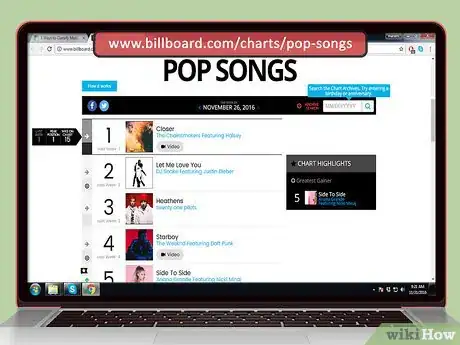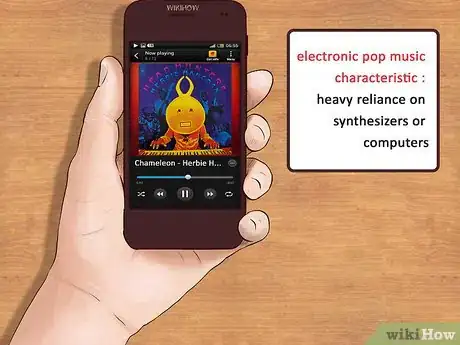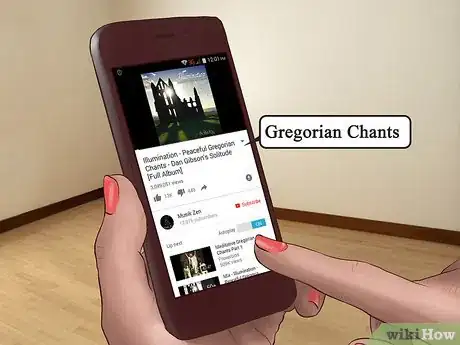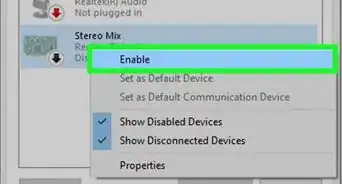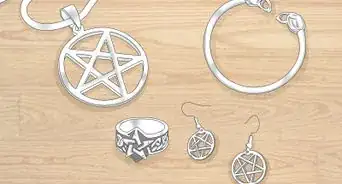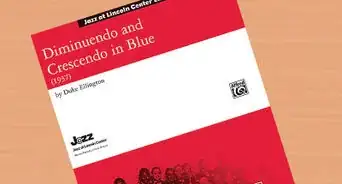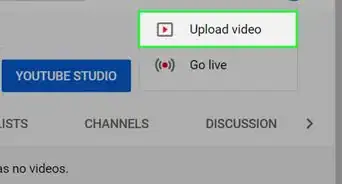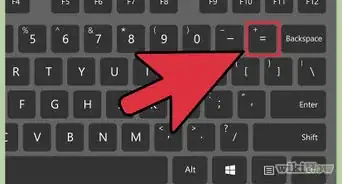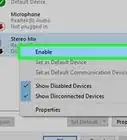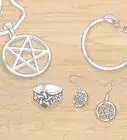This article was co-authored by wikiHow Staff. Our trained team of editors and researchers validate articles for accuracy and comprehensiveness. wikiHow's Content Management Team carefully monitors the work from our editorial staff to ensure that each article is backed by trusted research and meets our high quality standards.
There are 9 references cited in this article, which can be found at the bottom of the page.
This article has been viewed 171,152 times.
Learn more...
Classifying music into various genres does not have a right or wrong system. There are many genres, subgenres, and ways of classifying music. Fringe bands, new music developments, and overlapping genres will also contribute to the difficulty. There are some basic guidelines in determining the major genres of music that a song might belong to.
Steps
Determining the Different Genres of Pop Music
-
1Classify rock music. Rock n’ roll is a broad form of pop music that contains nearly a hundred spin offs and subgenres. The characteristic sound of rock n’ roll is a strong beat, simple (sometimes advanced) chord structure, and played loudly. Rock n’ roll was born in the 1950s out of rhythm and blues. It typically features an electric guitar (sometimes distorted), drums, bass, and vocals.
- There are several variations of rock n’ roll that makes defining the genre difficult.
- Some of the early rock pioneers are The Kinks, Rolling Stones, The Beatles, Buddy Holly, and Bo Diddley.[1]
- Rock n’ roll evolved through the 1960s, 1970s, and each following decade. In the 1970s, punk rock was born. In the 1980s, metal and hair metal was born. In the 1990s, grunge hit the scene as well as countless other styles.
- If you hear a song with a strong beat and personality, you might be correct to classify it as rock.
-
2Identify top 40 pop music. Top 40 is a way of tracking the success of a pop song, based on listeners and popularity. Today top 40 has turned into a genre of pop of its own. Its music is written by songwriters and produced by a music corporation. The easiest way to find this music is by skimming through your radio stations until you find the “pop” station.
- The songs of top 40, more than any other genre, are designed to be catchy and get stuck in your head. With this idea embedded into the songwriting process, top 40 songs typically have a grandiose chorus that repeats several times.[2]
- Some popular figures of top 40 hits are Justin Bieber, Katy Perry, Taylor Swift, and Keke Palmer.
Advertisement -
3Classify country music. Country music, like all other genres, continues to grow and develop into subgenres. Country music’s strongest emphasis is the narrative of the song. The song remains in a pop song format with a verse and chorus. It is also characteristic for the singer to have a bit (or a lot) of twang. Since country music is fixated more on the song’s narrative, instruments play less of a role. Instruments popular in country music are acoustic guitars, pedal steel guitars, and other folk instruments.[3]
- The roots of country start with the honky tonk days of the 1950s. The most celebrated star from this decade is Hank Williams.
- Folk music is another popular subgenre of country. Folk music takes the narrative focus of country and intensifies the storytelling. Popular folk musicians are Woody Guthrie and Bob Dylan.
-
4Understand soul and R&B. Soul and rhythm & blues are genres of music inspired by gospel and blues music. These genres represent a larger umbrella of genres of music created by African Americans. Soul music is characterized by powerful vocals and a catchy groove accompanying it. R&B is another large genre that has roots in the 1950s and transformed around the late 1980s into a catchier form of pop.
- Early soul pioneers include Solomon Burke, Ben E. King, and Aretha Franklin.
- Early R&B started in a minimal style like Big Joe Turner and Fats Domino. The genre took on more influences in the 1960s with the Mar-Keys and James Brown. Later R&B took on a hip hop influence with artists like Mary J. Blige and Boyz II Men.
- Another influential genre that took shape under these genres is funk. Funk is all about being exceptionally groovy. Listen to artists like Funkadelic, 1970s era James Brown, and Sly Stone and the Family Stone.[4]
-
5Identify rap and hip hop. Rap and hip hop has an easy indicator to tell you what genre you’re listening to. The name comes from the vocalist rapping over the beat. Rap is a form of poetry that accompanies music. Rap and hip hop got its start in the late 1970s with acts like Grandmaster Flash and Blowfly. The genre evolved, and continues to evolve.[5]
- Today rap is a major influence on pop music.
- Some examples of rap's subgenres are gangsta, trap, chicano, and ghetto house.
-
6Classify electronic music. Electronic music is another umbrella that can crossover into multiple genres. The key indicator of electronic pop music is the heavy reliance on synthesizers or computers. Synthesizers became accessible to artist in the 1970s, which can be heard on Herbie Hancock's 1973 hit, “Chameleon.”
- Electronic music has developed into several genres of popular music. In the 1990s, techno became a popular dance music that is still happening. Techno evolved into EDM and dubstep, which are both popular.
- There is electronic aspects in a vast amount of music being produced today.
Sorting Music as Experimental
-
1Know experimental music’s roots. Experimental music began to take shape in the early to mid 1900s with the rising influence of Black Mountain College. Several classically trained composers began to experiment with what it means to write a composition. Today several artists and musicians take a pop genre, like techno, and experiment with it. The result, if done successfully, is an entirely different sound.
- An example is Stockhausen’s “Helicopter String Quartet,” which requires four helicopters and each member of the quartet to occupy a separate helicopter while playing in unison.[6]
-
2Determine a blend in pop and experimental music. Since the 1960s, certain musicians have been interested in blurring the line between a conventional pop song and something completely different. There is a trend in psychedelic experimental music to disrupt pop conventions. Bands like Acid Mother Temple do this by creating a hook through a melody and then branch off into a cosmic jam.
- Captain Beefheart’s infamous album, Trout Mask Replica, is a fully composed album, but the record sounds like improvisation and insanity.
-
3Identify ambient music. In the mid 1970s, when the synthesizer were beginning to build momentum, certain artist found a new way to use the instrument. Being inspired from Indian ragas and other types of droning Eastern classical music, ambient music creates an atmosphere for the listener.
- Brian Eno popularized ambient music with compositions like “Music for Airports,” which was composed to be played in airports.
- Another interesting cross genre is noise music. Noise music is loud and chaotic, but it oftentimes creates a consistent ambient wall of sound.
-
4Know minimalist music. Minimalist music refers to a specific scene of musicians in the 1960s up to the present day, who wrote music “minimally.” The term itself does not fairly describe the music. Minimalist music is best characterized by several “minimal” layers of music stacked on top of each other to create something incredibly complex.
- Philip Glass wrote an opera called “Einstein on the Beach,” which embodies this idea of stacking minimal melodies to create something massive.
- Other pioneers of the genre, Steve Reich and Terry Riley, have their own style of creating minimalist music.
Identifying Classical Music
-
1Look at the time period the piece of music was written. For classical music, much of the classification relies heavily on what century the piece was written. Typically when people talk about “classical music” they are referring to European music. The date of a piece of music can tell you information about the art movement the piece was written. Art movements act, in a way, as genres for classical music.
- To best understand classical music and its characteristics, learn the different art movements.
-
2Identify early classical music. Early classical music refers to music created by monks and Roman Catholic church officials before the 9th century. The earliest example of this style is the Gregorian Chants. Legend claims the chants were written by Pope Gregory, but scholars are now skeptical of this claim. The chants were performed by a group of monks. This is the first time music was written down in musical notation and features melodies to be sung along with words (in Latin).
- A good indicator that music is from this time period is if it is a cappella and sung in Latin.
-
3Classify Baroque music. The Baroque era is best exemplified as being artistically grandiose and features elaborate decorations. The influence of the church started to weaken in this era, which roughly lasts from 1600 to 1750. The Baroque era birthed orchestral music and opera. Another key sound of the Baroque era is the harpsichord.[7]
- The harpsichord is played like a piano, but instead of hitting the strings with soft mallets, the strings are plucked like a harp. This gives the harpsichord a unique and sharp tone.
-
4Identify the “classical” movement. The classical period contains some of the most identifiable pieces of music. This is the era of recognizable composers like Mozart, Beethoven, Haydn, and Schubert. Classical music is known for its finely tuned attention to detail and structural clarity. Instead of a rococo style of decorative detail, music from the classical age focused on symmetry and sensibility.[8]
- This era runs parallel with the intellectual movement called the Enlightenment. The Enlightenment birthed the rising belief that human reasoning can overcome problems of the world. This influenced the way composers treated compositions.
-
5Identify the Romantic era. The Romantic era of music lasted from 1820 up into the 20th century, ending roughly in 1915. Key identifiers of music from this era are its implications of fantasy, spontaneity, and sensuality.[9] The artistic movement itself was centralized on the idea of fleeting back to nature due to the Industrial Revolution.
- Another popular concept explored in the Romantic period was color. Composers began viewing the orchestra as a palette that could depict an array of exotic scenes.
- A sub-movement within the Romantic era is Impressionism. Similar to Impressionist painters like Monet, composers attempted to imprint an impression on the listener. For example, Erik Satie wrote a series of compositions called “furniture music,” which was the first time someone wrote music intended to be in the background.
-
6Understand modern classical music. Music from the end of the Romantic period, around 1915, into the 20th century is considered modern classical music. Modern music is exemplified by various moods of extreme. Since the history of music styles are so vast, composers of this era attempted to break new grounds with their compositions.
- For example, Igor Stravinsky broke new grounds by composing a ballet about a pagan myth. The premiere nearly caused a riot from the audience.
- The modern movement also birthed experimental music with such figures like John Cage and Karlheinz Stockhausen.
-
7Learn key figures and pieces of classical music. Take a look at the various movements and determine if you can name a piece of music or composer from each period. A good way to practice learning the different eras is by reading about the time period while listening to a piece of music from that movement. For music students, it is required to identify a piece of music based off a sound clip. Here are some pieces that accompany each time era:
- Early classical music is best heard in the Gregorian Chants and other choral music.
- Baroque music has two heavyweights: Bach and Handel. Bach’s cello suite no.1 in G might be his most recognizable.
- The classical period has several popular composers. Popular pieces from this era include Mozart’s Eine Kleine Nachtmusik or Beethoven’s Symphony No. 9.[10]
- For the Romantic era, listen to Liszt’s Liebestraum or Chopin’s Etude Opus 25.
- Modern music is so vast, but some key pieces are Stravinsky's The Rite of Spring and John Cage’s 4’33.
Community Q&A
-
QuestionWhat are the different music genres?
 Community AnswerThere are many different genres of music, such as classical, rock, jazz, and pop.
Community AnswerThere are many different genres of music, such as classical, rock, jazz, and pop. -
QuestionWhat is Meltycanon's genre?
 Weirddogfromthe90sCommunity AnswerBubblegum trap. It is a type of trap coined by Lil Yatchy in 2016. It can also be called bubblegum pop.
Weirddogfromthe90sCommunity AnswerBubblegum trap. It is a type of trap coined by Lil Yatchy in 2016. It can also be called bubblegum pop. -
QuestionDo anthems belong to any particular genre of music?
 Community AnswerMost, if not, all anthems are played by orchestras or bands. Many anthems are either hymns or marches, and a few European anthems were written by classical music composers, like Haydn, Beethoven, and Mozart to name a few. Therefore, the majority of anthems are either classical or martial music.
Community AnswerMost, if not, all anthems are played by orchestras or bands. Many anthems are either hymns or marches, and a few European anthems were written by classical music composers, like Haydn, Beethoven, and Mozart to name a few. Therefore, the majority of anthems are either classical or martial music.
References
- ↑ http://www.shsu.edu/lis_fwh/book/classic_rock_n_roll/Rock%20'n'%20Roll2.htm
- ↑ http://blogs.scientificamerican.com/observations/is-pop-music-evolving-or-is-it-just-getting-louder/
- ↑ http://www.countryweekly.com/music/real-country-music-honest-truth-about-country-music-sub-genres
- ↑ http://www.georgiaencyclopedia.org/articles/arts-culture/rhythm-and-blues-music-overview
- ↑ http://pigeonsandplanes.com/2014/07/it-is-a-business-after-all-how-features-in-rap-work/
- ↑ http://mentalfloss.com/article/51417/7-experimental-adventures-classical-music
- ↑ http://www.musicgenreslist.com/music-classical/
- ↑ http://cmed.faculty.ku.edu/private/classical.html
- ↑ http://www.musicgenreslist.com/music-classical/
About This Article
To classify music by genre, listen to the instruments and vocals it uses, which are a bit different for each genre. Rock music tends to feature drums and electric guitar, which is sometimes distorted. Country music often has acoustic guitar and singing with a southern twang, which tells a story. Soul and Rhythm and Blues are genres rooted in African American culture, which often have powerful vocals and groovy melodies. You can easily identify rap music from the emphasis on fast vocals over a repeated beat. Electronic music, as the name suggests, uses lots of computers and synthesizers to layer melodies and rhythms. Modern pop music incorporates styles from all of these genres and indicates music in the charts or on the radio. For more tips, including how to identify classical music, read on!

